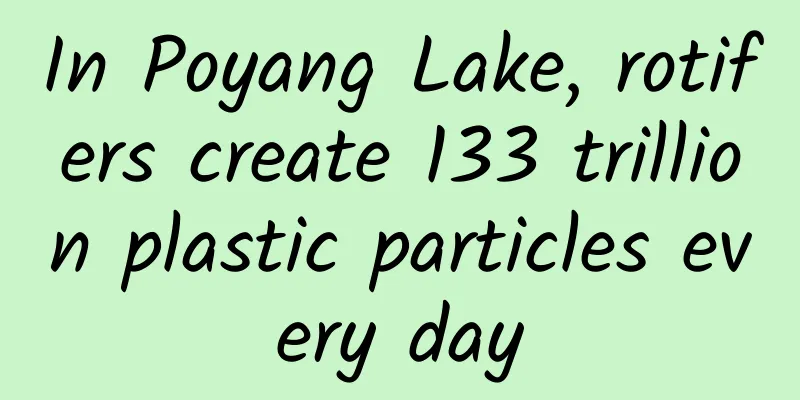In Poyang Lake, rotifers create 133 trillion plastic particles every day

|
The total number of nanoplastic particles produced by rotifers in Poyang Lake every day: 1 followed by 16 zeros. As the use of plastic products becomes more and more widespread in our lives, the amount of plastic particles in our environment is also increasing. They are everywhere, from the Arctic to the Antarctic, from soil to rivers, from the ground to the clouds, and even in the air we breathe every day. Rotifer (Image credit: Juan Carlos Fonseca Mata, CC BY-SA 4.0, via Wikimedia Commons) These invisible plastics are divided into two categories: microplastics with a size between 1 micron and 5 mm, and nanoplastics with a size less than 1 micron. More and more studies have shown that nanoplastics can damage the functions of various organs and systems in the human body. Microplastics and nanoplastics come from the degradation of plastic products. Unrecycled plastic waste may enter rivers and oceans and be carried around the world. After dozens or hundreds of years, mechanical and photochemical processes will break down this long-chain polymer material into small pieces. At the same time, biological processes also accelerate this process. A 2018 study showed that Antarctic krill (Euphausia superba) can ingest microplastics and grind them into nanoplastics using their mandibles (the krill's chewing organs). Antarctic krill (Photo credit: Yale Peabody Museum, CC0, via Wikimedia Commons) Professor Xing Baoshan of the University of Massachusetts has been engaged in microplastic research for many years. After reading this paper, he realized that since Antarctic krill, a creature living in the remote polar regions, can "decompose" microplastics, then in our daily lives, are there also creatures that can produce the same effect, and thus affect the content of nanoplastics in the environment? So he collaborated with Professor Zhao Jian of the Ocean University of China to start studying this issue. They chose rotifers as their research object. This is a common zooplankton widely distributed in surface waters around the world, most of which are no longer than 0.5 mm. For example, in Poyang Lake, my country's largest freshwater lake, there are more than 900 rotifers per liter of lake water. Moreover, like Antarctic krill, they have a unique chewing device that grinds the ingested algae into small pieces through mechanical action. The researchers looked at two species of rotifers, Brachionus plicatilis and B. calyciflorus, which live in the ocean and freshwater, respectively. They found that both rotifers ingested large amounts of plastic smaller than 10 microns , which is similar to the size of their daily food. They also occasionally ate plastic as large as 20 microns, but could not eat anything larger than that. Microplastics (green balls) ingested by rotifers and nanoplastics (green dots) produced by grinding. Image source: original paper The researchers observed under a microscope that after rotifers ate microplastics, many plastic particles of different sizes appeared in their digestive tracts, with nano-sized plastic particles far outnumbering micro-sized ones . The smooth, spherical microplastics originally provided to rotifers became rough on the surface after digestion, as if they had been gnawed. It can be seen that the tooth-like structure in the rotifer chewing device "picks" off these plastic fragments from the surface of the microplastics little by little by grinding. Finally, the fragmented microplastics will be discharged from the rotifer's body and return to the water. Plankton affects the world What we call "plastic" is actually a general term for a class of high molecular polymers. The most common ones in our daily lives are polyethylene (PE), polypropylene (PP), polyethylene terephthalate (PET), polyvinyl chloride (PVC) and polystyrene (PS). They have different constituent units, and their hardness, tensile strength, photoreactivity and bioreactivity vary. Different plastic types and properties. Image source: original paper In this study, researchers found that rotifers can ingest and break up PE plastics with lower hardness, and can also effectively wear out nanoplastic particles from PS plastics with higher hardness . This shows that rotifers are universal in their "digestion" of different types of microplastics. More importantly, the researchers also collected samples of rotifers of different species from Shuyuan Reservoir, Baisha River, Dagu River and Jiaozhou Bay in Qingdao, Shandong Province. As a result, microplastics with a size of 3 to 30 microns were detected in the rotifers of all sampling points. It can be seen that even in the natural environment, without researchers "feeding" microplastics, this phenomenon is common. Therefore, rotifers are likely to play an important role in the distribution of microplastics and nanoplastics around the world, and this is indeed the case. The researchers found that around the world, especially in East Asia and Europe, areas with high abundance of microplastics are also areas with the highest abundance of rotifers , with a high degree of geographical overlap between the two. The global distribution of rotifers (left) and microplastics (right). Image source: original paper How terrible is the actual situation? In order to give people a more concrete perception of this impact, the researchers used Poyang Lake as an example. Poyang Lake covers an area of about 3,690 square kilometers. Literature shows that on average, each liter of Poyang Lake water contains about 20.2 microplastics with a diameter of 50 to 500 microns. Assuming that all rotifers live in lake water no deeper than 5 meters, according to the data of this study, after 4 hours of placing rotifers in water containing microplastics, an average of 131 nanoplastic particles will be generated for each microplastic particle. Then, at the end of the day, the rotifers in the entire Poyang Lake can produce a total of 133 trillion (1.33×10^16) nanoplastic particles. However, this is just a calculation result, and the actual number may be even higher . On the one hand, due to experimental conditions, researchers can only detect nanoplastics with a diameter greater than 0.6 microns . Therefore, we do not know how many smaller nanoplastics can be generated by a microplastic being worn away by rotifers. But it is clear that the actual nanoplastic particles generated must be much higher than the experimentally measured data. Rotifers excrete "digested" microplastics from their bodies. Image source: original paper Second, only microplastics with a size range of 50 to 500 microns have been reported in the literature, while rotifers mainly ingest smaller microplastics. Although the concentration of microplastics with a diameter of less than 50 microns in Poyang Lake is not yet known, researchers estimate that it must be much more abundant than large-sized microplastics. Therefore, the actual number of microplastic particles in the rotifer's living environment is also higher than the value used in the estimate. Third, the experimental conditions are different from natural conditions. During the experiment, the researchers put 9.3 million initial microplastic particles in each liter of water, but only 20,000 rotifers; while in the literature, the average microplastic content per liter of Poyang Lake water was 20.2, but the number of rotifers was 909. Therefore, the rotifers in Poyang Lake can more fully ingest and digest the microplastics in the lake water , and each microplastic will also produce more than 131 nanoplastics. In addition, the researchers only tested "fresh" microplastics and microplastics that were briefly exposed to simulated sunlight for 12 hours. However, microplastics in nature often experience years of wind and sun, which can change their morphology and chemical properties and make them more fragile. Experiments have shown that rotifers that ingest light-aged microplastics produce more plastic fragments than when they ingest original microplastics . Most rotifers live in waters that are permeable to light, and the microplastics they ingest are exposed to sunlight for much longer than the experimental conditions, so the results are bound to be more terrible. Finally, Poyang Lake is just one case. In fact, the content of microplastics and rotifers in many surface waters on Earth is much higher than that of Poyang Lake. For example, literature shows that there are about 500 microplastics per liter in the Yellow River, and about 10,133 rotifers per liter in the mouth of the Adyar Creek in India. Therefore, we may have greatly underestimated the role of organisms in this global nanoplastic "plague". Reference Links [1]https://www.nature.com/articles/s41467-018-03465-9 [2]https://www.science.org/doi/10.1126/science.abb0354 Planning and production Source: Global Science (id: huanqiukexue) Written by Huang Yujia Review | Winter Kite Editor: Wang Mengru |
<<: Polymer fluids: Uncovering the amazing science behind everyday products
Recommend
Why do wind turbines have to have three blades? This is related to the efficiency of wind energy conversion
Old-style electric fans are composed of three bla...
Scientists have found the gene that controls fish bones, making it possible to eat fish without picking bones
There are often such troubles in life Crucian car...
The efficacy and function of small white cotton
Xiaobai cotton is a traditional Chinese medicine ...
Why is Qinling Mountains called the “Central Water Tower”?
The Qinling Mountains unite the north and south a...
There are other things you don’t know about my country’s manned space station →
China Aerospace Science and Technology Corporatio...
Don't make the mistake again! The secret to quickly distinguish peach, plum, apricot, cherry and plum, teach you how to do it in 1 minute
Every spring, flowers of all colors compete with ...
With 120 minutes left before sudden death from myocardial infarction, what else can we do?
I hope everyone can master a little more first ai...
He was snoring like thunder, but he was sound asleep, and I couldn't stand it anymore...
If I am guilty, please let the law punish me, ins...
The efficacy and function of Daqingmu [picture]
Most Chinese medicinal materials have good effect...
The efficacy and function of sisal
I believe many people are familiar with the Chine...
Parents, these 6 foods you think are healthy are actually not very nutritious...
"Eating more of this is good for your health...
Primary school students’ “Buddhist style of skewers”, do you get it?
Review expert: Zhu Guangsi, member of Beijing Sci...
The efficacy and function of banana flowers
Banana flower is a common medicinal material in t...
After the age of 40, "brittle bones" are very serious! This screening must be done! Especially for these 5 groups of people...
They live cautiously every day, dare not lift hea...
Can’t eat eggs and soy milk together? You must know these 5 truths about eggs!
During the stay-at-home period, every refrigerato...









